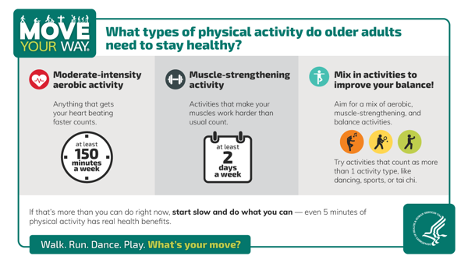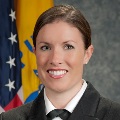Dr. Katrina Piercy, FACSM, is the director of the Division of Prevention Science within the U.S. Department of Health and Human Services’ (HHS) Office of Disease Prevention and Health Promotion (ODPHP), having taken on the role in January 2022. Piercy earned a Ph.D. in exercise physiology and nutrition from Virginia Tech (in the department now headed by ACSM President-Elect Stella Volpe) and began working with ODPHP as a fellow in 2011; Piercy has since held a number of roles and leadership positions within the office, also joining the U.S. Public Health Service as a dietician officer in 2013.
Piercy’s division develops and disseminates the Physical Activity Guidelines for Americans (Guidelines), the National Youth Sports Strategy, and the Dietary Guidelines for Americans. They also support the President’s Council on Sports, Fitness & Nutrition, a federal advisory committee appointed by POTUS that promotes physical activity and healthy eating for all Americans.
In her capacity as division director, Piercy was the federal lead overseeing the entirety of the development of the Physical Activity Guidelines for Americans Midcourse Report: Implementation Strategies for Older Adults (Midcourse Report). In this Q&A with ACSM, Piercy discusses her background and work as well as insights into the report’s creation, its highlights, and actionable content for ACSM members and certified professionals.
What led you to pursue a career in exercise science and sports medicine?
I was a college athlete, playing soccer on scholarship, and I was always interested in the combination of physical activity and nutrition and how to optimize both. I specifically sought out graduate schools where I could combine both disciplines into one department and do research with human subjects. After graduate school, I did my dietetic internship at the National Institutes of Health (NIH) and was drawn to their program for the opportunity to be involved with many of the research studies at NIH.
What does your day-to-day work look like?
It honestly changes every day, depending on the projects we are working on. Currently, my team is working to disseminate findings from the Midcourse Report, getting the new members of the Biden-Harris administration President’s Council on Sports, Fitness & Nutrition — who were just sworn in at their meeting in late June — up to speed and starting to work, and preparing for meeting No. 3 of the 2025 Dietary Guidelines Advisory Committee, which will take place in September.
How did you get involved with the production of the Midcourse Report?
On behalf of HHS, our office leads development of the Physical Activity Guidelines for Americans in close collaboration with other federal offices, including the Centers for Disease Control and Prevention (CDC) and the NIH. We began planning for the Midcourse Report in late 2020.
What is the purpose of the report, and what do you hope to achieve with its publication?

The Midcourse Report extends the work of the Guidelines and provides the “how” to help older adults achieve the recommended 150 minutes or more of moderate-intensity aerobic physical activity and two days of muscle-strengthening physical activity each week. In addition, older adults also need multicomponent physical activity, which incorporates balance training as well as aerobic and muscle-strengthening physical activity.
Older adults were selected for this report because they are an expanding population with low rates of physical activity (less than 15% are currently meeting the Guidelines) and because of the physical, mental, social, and economic benefits of physical activity for older adults.
The purpose of this report is to highlight strategies that work to increase physical activity among older adults. This report is for policymakers; exercise and health professionals; clinicians; gerontologists; built-environment professionals; local, state, territorial, and Tribal leaders; and others working with older adults.
Of note, the Biden-Harris administration’s National Strategy on Hunger, Nutrition, and Health specifically called for this report after the historic White House Conference on Hunger, Nutrition and Health in September 2022. Summarizing evidence-based strategies to increase physical activity among older adults directly supports the National Strategy’s Pillar 4: Support Physical Activity for All.
How is the report formulated?
The report is primarily based on a systematic literature review performed with support from the President’s Council on Sports, Fitness & Nutrition Science Board. It examined how effective a variety of settings are for supporting increased physical activity among older adults. These settings included communities; assisted living facilities; faith-based settings; health care institutions; and homes, independent living facilities, and neighborhoods.
Additionally, successful interventions from Step It Up! The Surgeon General’s Call to Action to Promote Walking and Walkable Communities and The Guide to Community Preventive Services are incorporated in this report.
What are the most important takeaways from the current report?
Here are a few of the key messages from the report:
- It’s never too late to start being physically active and gain substantial health benefits.
- While people can do physical activity in many locations, the Midcourse Report identifies three key settings for successful physical activity interventions:
- Community locations like schools, gyms, senior centers, or outdoor parks or trails
- Health care locations, e.g., doctors’ offices, rehabilitation/physical therapy centers, or nursing homes
- At home, where older adults spend much of their time and may be most comfortable
- The report outlines several strategies proven to increase physical activity among older adults. They include:
- Behavior change strategies — physical activity counseling, for example
- Physical activity programs like exercise classes
- Policy, systems, and environmental approaches such as walkable, pedestrian-friendly neighborhoods and communities
What can/should ACSM members and certified professionals do with this information?
A key audience for the report is health professionals and clinicians, which includes exercise physiologists, physical therapists, personal trainers, and physicians — all ACSM members! Below are some of the strategies that health professionals can use when they work with older adults.
Professionals working with older adults can:
- Help them set self-selected physical activity goals, monitor their progress, use problem-solving to overcome barriers to physical activity, and build social support;
- Consider individual factors, social and environmental factors, and cultural factors when providing tailored physical activity guidance;
- Help older adults transition from programs or care within the health care setting to community programs by providing referrals to exercise and health professionals or programs and resources that fit their needs; and
- Provide guidance and recommendations to help older adults engage in more physical activity, such as through active transportation and leisure-time physical activity.
ACSM members can use Move Your Way® resources and share information with their patients and clients. Move Your Way is the promotional campaign for the Guidelines and contains over 80 resources in English and Spanish tailored to a variety of audiences, including consumers and health professionals. The campaign materials for older adults help older adults understand the amount and types of physical activity they need to be healthy. Of note, a new fact sheet for health care providers shares information about how to discuss physical activity with older patients. The fact sheet also points to helpful resources like Exercise is Medicine®, workout videos for older adults, and an interactive physical activity planner.
Additionally, CDC leads the Active People, Healthy NationTM initiative, a program that provides resources and tools to help 27 million Americans become more physically active by 2027. There are a number of resources for community design, a key component of the policy, systems, and environmental approaches discussed in the Midcourse Report. Improving community design elements can increase physical activity for older adults, as well as everyone in the community.

Katrina Piercy, PhD, FACSM, is the director of the Division of Prevention Science within the U.S. Department of Health and Human Services’ Office of Disease Prevention and Health Promotion, which produces the Physical Activity Guidelines for Americans Midcourse Report: Implementation Strategies for Older Adults.




